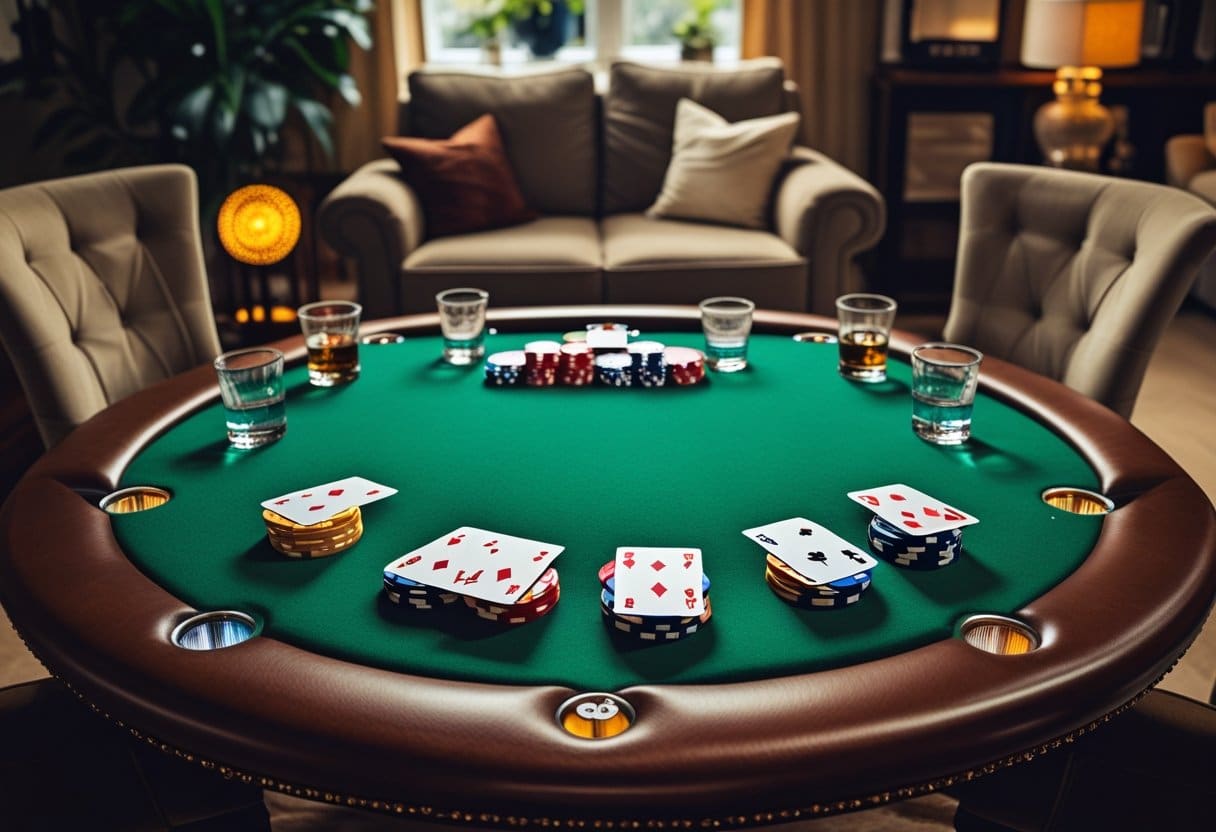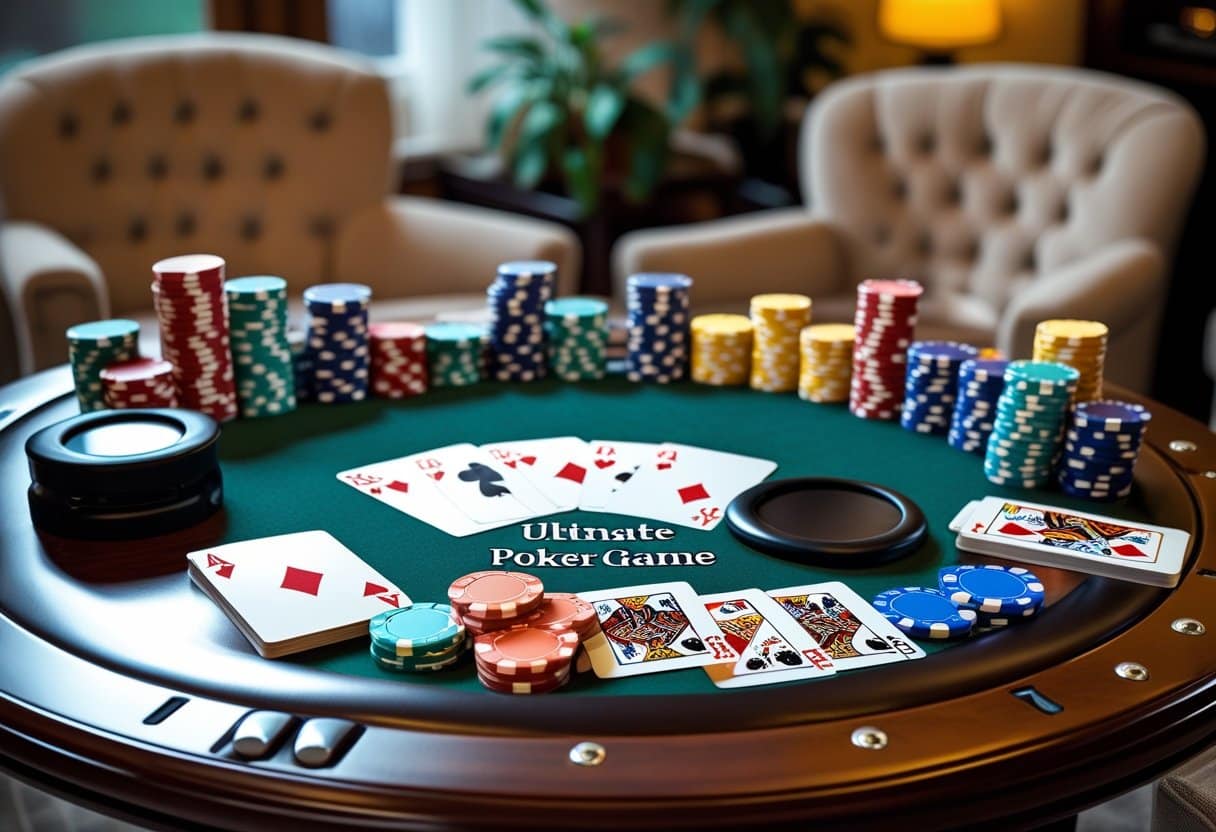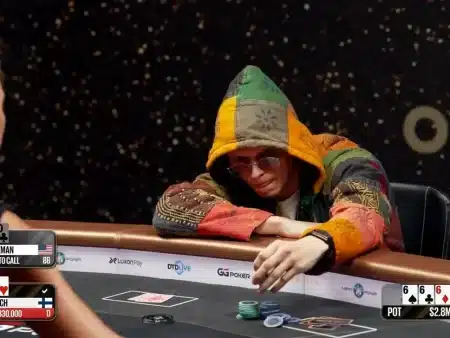Setting up a home poker tournament takes more than just grabbing a deck of cards and a pile of chips. You need a bit of planning, some decent equipment, and a set of clear rules if you want everyone to actually enjoy themselves.
A successful home poker game really needs a printed set of rules before the first hand is dealt. Otherwise, you just know there’ll be disputes and the tournament will get derailed.

Poker tournaments at home aren’t quite the same as your average casual game. You’ll want a structure—blind levels, starting chip stacks, and time limits that actually work for your group.
Most folks find a simple color-coded chip system does the trick. Reds worth 5, greens 25, blacks 100, blues 500—easy enough for everyone to keep track.
If you’re expecting 8-10 players and a modest $20 buy-in, a little organization goes a long way. Quality poker supplies, a clear betting structure, and a comfortable setup can turn a regular hangout into something folks look forward to.
When you get the setup right, it’s that sweet spot between real competition and just hanging out with friends.
Essential Poker Equipment

Getting the right gear is half the battle if you want your poker game to feel legit. Good equipment just makes everything feel more professional, and honestly, it’s more fun to play with.
Choosing the Right Poker Chips
Poker chips are kind of the heart of any home game. Clay chips have that classic casino feel—hefty (usually 9-13.5 grams) and that satisfying clack when you stack ‘em.
They’re not cheap though, usually running $0.50-$2 per chip. Ceramic chips look great and last forever, but they’ll cost you even more.
If you’re not looking to break the bank, composite chips are a solid pick. You can snag a 300-piece set for around $30 and they still have a nice weight.
For most home games, a good mix is:
- 100 white chips ($1)
- 75 red chips ($5)
- 50 green chips ($25)
- 25 black chips ($100)
Keep chips in cases or trays between games. During play, a lot of people like stacking chips in neat piles or little pyramids—it just looks good and keeps things organized.
Selecting Poker Tables and Seating
A proper poker table really does take things up a notch. Oval tables that seat 8-10 are pretty much ideal for most home games.
Look for something with padded rails and cup holders—nobody wants a spilled drink on their chips. Fold-up tables with speed cloth are surprisingly good value ($150-300), and you can stash them away easily.
If you’re really into it, custom tables with chip trays and leather rails ($500-1500) are about as fancy as it gets.
Chairs matter more than you’d think. Go for padded seats with decent back support, and make sure they’re the right height for the table.
Armless chairs let you squeeze in more players, and wheels make moving them around a breeze. The right setup gives everyone a spot and keeps things tidy.
Cards, Accessories, and Game Atmosphere
Don’t skimp on cards. 100% plastic decks ($4-15 per deck) won’t bend or get ruined by a little spilled drink, and they last way longer than paper ones.
Always have at least two decks on hand—nobody likes waiting for a shuffle.
Some accessories you’ll want:
- Dealer button
- Blind buttons
- Cut card
- Card shuffler (if you’re feeling fancy)
- Tournament timer
Lighting is a bigger deal than you might think. A good lamp above the table gets rid of shadows and sets the mood.
A chip tray helps keep buy-ins and cash-outs organized. If you want to get high-tech, a digital scoreboard or tournament clock is a nice touch.
Throw on some background music—just not too loud, or it’ll drive everyone nuts.
Game Formats and Poker Variants
Picking the right poker variant and game format can make or break your home game. Switching things up keeps the night interesting and gives everyone a shot, no matter their skill level.
Texas Hold’em and Omaha Variations
Texas Hold’em is the classic for a reason. Each player gets two cards, five community cards go in the middle, and you try to make the best hand.
It’s simple enough for newbies but deep enough for serious play. No-Limit Hold’em brings the drama—bet your whole stack any time, which can lead to some wild hands.
Pot-Limit Hold’em is a bit less swingy, since the max bet is whatever’s in the pot. There’s still room for strategy, but it’s a little less crazy.
Omaha shakes things up with four hole cards per player, but you have to use exactly two. More cards means more drawing hands and bigger pots.
Pot-Limit Omaha (PLO) is catching on fast. Those four-card hands make for huge pots and plenty of action.
Limit Poker and Other Popular Games
Limit poker is great for beginners or anyone who hates losing their whole stack in one hand. Fixed-Limit Hold’em has set bet sizes, so there’s less risk and more control.
Seven-Card Stud used to be the king before Hold’em took over. Players get seven cards across several rounds, and you have to keep track of what’s out there.
Badugi is a fun curveball—a draw game where you want the lowest hand with all different suits. It’s quirky and adds a bit of variety.
Mixed games like H.O.R.S.E. (Hold’em, Omaha, Razz, Stud, Eight-or-better) keep things interesting for experienced players. For most home games, though, just mixing in Hold’em and Omaha is plenty.
Structure of Cash Games
Cash games are nice if people want to come and go as they please. Players buy in for a set amount and can cash out whenever.
Set reasonable minimum and maximum buy-ins. Something like $20 minimum and $100 max works for most groups.
Table stakes mean you can only bet what’s on the table—no digging into your pocket mid-hand. That keeps things fair.
Blinds should scale with your buy-in. For $20-$100 buy-ins, $0.25/$0.50 or $0.50/$1 blinds work well. That gives players a decent stack to play with.
If you’re covering snacks or drinks, maybe take a tiny rake from each pot—say 5%, with a cap. Just don’t overdo it.
Rules, Actions, and Player Guidelines
You can’t have a good poker night without some ground rules. Clear guidelines keep things friendly and prevent those awkward arguments nobody wants.
Standard Home Poker Rules
First, pick your game—Texas Hold’em, Omaha, whatever. Make sure everyone knows the hand rankings.
A printed chart on the table can help the newer folks. Define your betting limits:
- No-Limit: Bet up to your whole stack
- Pot-Limit: Max bet equals the pot
- Fixed-Limit: Set bet sizes only
Blinds should fit your group’s comfort zone. $0.25/$0.50 blinds with $10-$25 buy-ins are good for casual games. If your group’s more serious, maybe $1/$2 with $50-$200 buy-ins.
Decide how you’ll handle late arrivals and rebuys. Most home games allow unlimited rebuys until a set time.
Hand Actions and Betting Structures
Players should act in turn and say what they’re doing—check, bet, call, raise, or fold. If you say it, you’re doing it, even if you mess up your chips.
String betting (moving chips in multiple motions) is a no-go. You’ve got to put your whole bet in at once or say the amount first.
Set up some basics for each round:
- Minimum raise (usually the last bet size)
- Max number of raises per round (or just let it go unlimited)
- Time limits for decisions—30 to 60 seconds is fair
Use a dealer button and move it clockwise after each hand so everyone knows whose turn it is to post the blinds.
Managing Discussions and Resolving Issues
Keep table talk friendly, but don’t discuss hands that are still going, especially if you’ve folded. It’s just bad form.
For disputes, the host usually calls the shots. If there’s a real rule question, maybe let the most experienced player weigh in.
A few things to sort out before you start:
- Exposed cards: Usually dead if shown during a hand
- Misdeals: Decide when to redeal or keep playing
- Slow play: Figure out how to nudge players who take forever
Agree on when to take breaks, what’s allowed at the table (food, drinks, phones), and you’ll avoid most headaches.
Organizing Poker Tournaments
Home poker tournaments are a great way to bring a little excitement and structure to your game night. If you get the details right, everyone knows what’s happening and stays engaged.
Tournament Types and Structures
There are a few different tournament types, each with its own vibe. Freeze-Out tournaments are the classic—once you’re out of chips, you’re out.
Rebuy tournaments let busted players buy back in during a set period, usually the first hour. This keeps the table full and the prize pool growing.
Add-on tournaments allow everyone to buy more chips at the end of the rebuy period, no matter their stack. It’s a last chance to stay in the game.
Satellite tournaments don’t pay cash—they offer seats in a bigger tournament. These are fun if you’re planning a bigger event down the line.
Turbo tournaments crank up the blinds fast, so the whole thing wraps up quicker.
Setting the Buy-In Amount and Prize Payouts
Set a buy-in that everyone’s comfortable with. For most home games, $10-$25 is perfect. If your group is a bit more serious, $50-$100 works.
A typical payout is to the top 30% of players. For ten players, maybe:
- 1st: 60% of the pool
- 2nd: 30%
- 3rd: 10%
With 16-20 players, you can pay out to 4th or 5th place:
- 1st: 50%
- 2nd: 25%
- 3rd: 15%
- 4th: 10%
Always collect buy-ins and announce prize amounts before you start. It avoids confusion later.
Determining Starting Chips and Blinds
You want enough chips for people to actually play, not just shove all-in every hand. A good rule is 50-100 times the starting big blind.
For a $20 buy-in, 2,000-5,000 starting chips is plenty. Use different denominations for easy betting.
For 5,000 chips, you might go with:
- 20 × 25 chips (500)
- 20 × 100 chips (2,000)
- 10 × 250 chips (2,500)
Blinds should start low—about 1-2% of the starting stack (25/50 for 5,000 chips). Increase them gradually so there’s real play at every stage.
Plan for 10-12 blind levels. Double blinds each level for a quick game, or bump them up by 50% for longer tournaments.
Establishing Tournament Timers and Length of Rounds
Blind levels usually last 15-30 minutes. Shorter levels mean a faster game; longer ones let people play more hands and think.
With 10 players and 20-minute levels, expect 2.5-3 hours. If you’ve got more players, say 16-18, it might run 3-4 hours.
Use a tournament timer app or website to keep things on track. Poker Timer Pro and Blind Valet are both solid—they show current blinds, next level, and countdowns.
Schedule a 5-10 minute break every hour or so. It’s just enough time for people to grab a drink or stretch.
Try to plan the tournament so the final table hits when you’re about a third of the way through the total time. It keeps the pace lively.
Enhancing the Home Poker Experience
There’s more to a great poker night than just cards and chips. The right atmosphere, a few tweaks, and maybe a bit of tech can really take things up a notch.
Hosting for Comfort and Fair Play
Keep it comfortable. Padded chairs are a must if you’re playing for hours. Lighting should be right above the table—no glare, but everyone can see their cards.
Don’t forget about temperature. A cool room keeps people alert, while a stuffy one just makes everyone sleepy.
Snacks and drinks are great, but stick to finger foods and use cups with lids. Nobody wants greasy cards or wet chips.
For fairness, put the dealer seat where everyone can see what’s going on. Some hosts rotate it after each hand.
If you want to keep things smooth, try to standardize things like shuffling and chip handling. Even the pros do it—WPT and WSOP both recommend it.
Gathering Feedback and Making Improvements
Getting regular feedback is honestly the best way to keep your poker nights improving. You could whip up a quick survey—nothing fancy—just asking about the tournament structure, blind levels, and how people felt overall.
Sometimes, a simple text poll right after the game does the trick. People tend to be more honest when they’re just tapping a button or two, and you’ll find out fast what worked and what was kind of a flop.
Don’t be afraid to ask for suggestions. Maybe someone wants longer levels in the tournament, or maybe they’re tired of fiddling with too many chip denominations during cash games.
Pay attention to which game variations actually get people excited. Maybe your group is all-in on Texas Hold’em, or maybe they’re itching to mix in a little Omaha or Stud.
If you do decide to make changes, it’s usually best to roll them out slowly. Give everyone a heads up before the next game so they’re not caught off guard.
Incorporating Technology and Online Poker Options
Digital timers on tablets can help keep blind levels consistent. There are plenty of free and paid poker timer apps, and some even let you tweak the structure to mimic WSOP tournaments if that’s your thing.
Card shufflers, whether mechanical or automatic, really speed up dealing. Honestly, the automatic ones feel like a little slice of the casino at home.
If you’ve got a spare TV, why not dedicate it to tournament info? It’s handy for showing blind levels, average stacks, who’s left—stuff everyone wants to know.
Looking for a hybrid setup? Online poker platforms let you host private games, which is pretty great for friends who can’t make it in person.
Some hosts even use poker tracking software to log stats from every game. It adds a bit of friendly rivalry, seeing your win rates and how you stack up over time.













